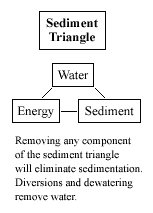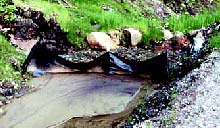| Forest Road Drainage Installation Practices | |
| in the Pacific Northwest | |
| 14 - Sediment Control | Planning, Installation, Catch Basins |

Dealing with suspended sediment is more difficult than preventing sediment generation or erosion. The Sediment Triangle shows that removing water or reducing stream energy is more effective than trying to remove sediment sources.
To avoid releasing large amounts of sediment during construction, a thorough assessment of the sediment generation potential is critical during site selection. Weighing alternatives and planning the installation before work begins can save environmental and financial embarrassment. Layout staff should seek advise from operators and supervisors at this early stage.
If in-stream work is required and fish habitat and water quality concerns exist, schedule work for periods of low or no water flows. If the construction timing can not be easily modified, develop a stream diversion plan that allows work outside regional fisheries windows. A high or very high risk assessment rating will often lead to the selection of a different crossing location or structure type.
Sediment release during drainage structure installation is commonly the result of exposed soil falling or ravelling into a stream, or of water eroding materials. Use stable cut/ fill slope angles, protect erodible materials from rain and water flows, and always try to work in dry conditions. If blanketing of fine-textured material is required, cover the soil as quickly as possible with a geotextile layer weighed down with rock or gravel. Logs, stumps and brush also provide effective initial surface erosion prevention, followed by prompt seeding. Spreading loose hay on exposed soil also provides short-term protection. Use products from the sediment control kit such as hay bales and silt fences as temporary measures at bottom of fills to catch fines before they can reach watercourses. If you anticipate sediment generation, build a downstream dam and pump silty water onto non-erodible vegetated sites nearby until work is complete or water runs clear.

In non fish-bearing streams, construct catch basins or sediment ponds directly downstream from the structure before construction begins. This prevents heavier suspended particles from reaching fish habitat. Use sandbags, gabions (wire baskets filled with small rocks), and geotextiles if rock is not available. Catch basins are most effective when built long, wide and shallow. In low-energy streams, hay bales weighed down with rocks or logs can be used as a catch basin dam and will filter out fines for many days. Wrap hay bales in geotextile for added filtration. Remove hay bales before water flows increase. Catch basins can also be used at culvert intakes on newly constructed ditches and cut slopes if sediment transport is expected. Try different combinations of hay bales, silt fences and rock.
Sediment Triangle Water Energy Sediment Removing any component of the sediment triangle will eliminate sedimentation. Diversions and dewatering remove water.
| 14 - Sediment Control |
| Next |
||
| PLANNING ISSUES |
INSTALLATION PRACTICES
|
|
©1999 - 2001 Flip Productions Limited Used with permission by CulvertBC |